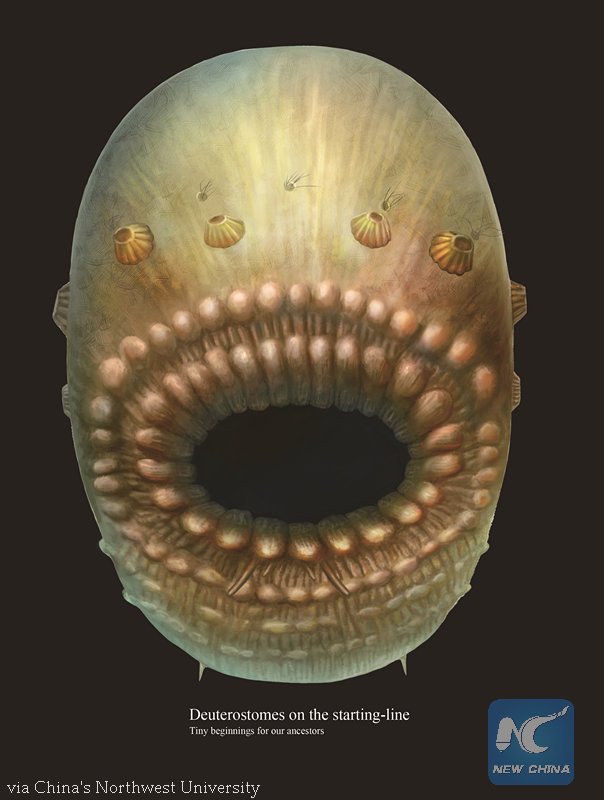Soheil_Esy
Fazanavard فضانورد
- Joined
- Apr 5, 2015
- Messages
- 744
- Reaction score
- 19
- Points
- 18
Disclaimer: Readers not familiar with paleontology, please skip.

To martins:

To martins:
2017-01-31 17:21:44
Scientists have discovered a tiny creature that dates back 535 million years and believe it may be the oldest known ancestor of a vast group of species, including humans.
The research was conducted by China's Northwest University, Cambridge University, and other institutions. The finding was published by "Nature" online Monday.
The animal is probably the oldest example of a category of creatures named deuterostomes that includes vertebrates.
Saccorhytus, about a millimeter in size, was found in Cambrian fossils from northwest China's Shaanxi Province. Its bag-like body has a prominent mouth but no anus. Several lateral openings probably served to expel water and waste materials.
The finding suggests that a key step in deuterostome evolution was the development of these lateral openings that subsequently became gills.
Shu Degan, an academician of the Chinese Academy of Sciences and an author of the paper, said deuterostomes dating back 520 million years were around a centimeter in size, so must had evolved from smaller ancestors.
"There were the tiny creatures first, then came primitive fish, and eventually humans," Shu said.

https://pbs.twimg.com/media/C3fWNIgXAAAnrro.jpg
https://twitter.com/XHNews/status/826364580880330752
This 535-mln-yr-old creature may be earliest human ancestor.
http://news.xinhuanet.com/english/2017-01/31/c_136022963.htm
Meiofaunal deuterostomes from the basal Cambrian of Shaanxi (China)
Published online 30 January 2017
Deuterostomes1 include the group we belong to (vertebrates) as well as an array of disparate forms that include echinoderms, hemichordates and more problematic groups such as vetulicolians and vetulocystids. The Cambrian fossil record is well-populated with representative examples, but possible intermediates are controversial and the nature of the original deuterostome remains idealized. Here we report millimetric fossils, Saccorhytus coronarius nov. gen., nov. sp., from an Orsten-like Lagerstätte from the earliest Cambrian period of South China, which stratigraphically are amongst the earliest of deuterostomes. The bag-like body bears a prominent mouth and associated folds, and behind them up to four conical openings on either side of the body as well as possible sensory structures. An anus may have been absent, and correspondingly the lateral openings probably served to expel water and waste material. This new form has similarities to both the vetulicolians and vetulocystids and collectively these findings suggest that a key step in deuterostome evolution was the development of lateral openings that subsequently were co-opted as pharyngeal gills. Depending on its exact phylogenetic position, the meiofaunal habit of Saccorhytus may help to explain the major gap between divergence times seen in the fossil record and estimates based on molecular clocks.

http://www.nature.com/nature/journal/vaop/ncurrent/images/nature21072-f3.jpg
http://www.nature.com/nature/journal/vaop/ncurrent/fig_tab/nature21072_F3.html
Reconstruction of Saccorhytus coronarius gen. et sp. nov. and the phylogeny of early deuterostomes.
a, Lateral, hind and ventral views. b, The most parsimonious tree (tree length, 96; consistency index, 0.6771; retention index, 0.8394; rescaled consistency index, 0.5683) arising from a matrix of 25 taxa and 61 characteristics. The values at nodes indicate bootstrap support greater than 50% (see Supplementary Information for details).

http://www.nature.com/nature/journal/vaop/ncurrent/images/nature21072-sf1.jpg
http://www.nature.com/nature/journal/vaop/ncurrent/fig_tab/nature21072_SF1.html
Geographical location of horizon and its petrography.
a, Locality map of the Zhangjiagou section, Xixiang, Shaanxi Province, China. In addition to Saccorhytus, the phosphatic limestone of Bed 2 of the Kuanchuanpu Formation in the Zhangjiagou section (see ref. 16) contains numerous small shelly fossils. b, c, Petrographic sections (plane-polarized light) of Bed 2 showing the phosphatic bioclastic grains, carbonate matrix and cements.
http://www.nature.com/nature/journal/vaop/ncurrent/full/nature21072.html#figures
Last edited:
